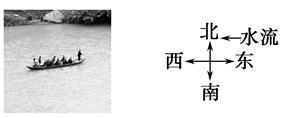问题
计算题
如图所示,有一条渡船正在渡河,河宽为300 m,渡船在静水中的速度是v1=3 m/s,水的流速是v2=1 m/s,求下列条件渡船过河的时间.

(1)以最短的时间过河;
(2)以最短的位移过河.
答案
(1)100 s (2)106.1 s
(1)当渡船的船头方向垂直于河岸时,即船在静水中的速度v1方向垂直于河岸时,过河时间最短,则

tmin= =
= s=100 s.
s=100 s.
(2)因为v1=3 m/s,v2=1 m/s,则v1>v2,故当渡船合速度方向垂直河岸时,过河位移最短,此时合速度如图所示,则渡河时间为

t= =
= =
= s=
s=
75 s≈106.1 s.
s≈106.1 s.
